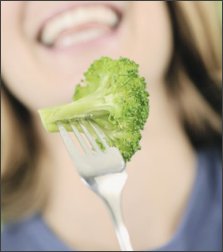Getting Past Passing Gas: How to Reduce or Eliminate the Problem No One Discusses, Flatulence
by www.SixWise.com
According to the American College of Gastroenterology, 10
to 18 passages per day are normal. Despite its apparent popularity,
passing gas is something that is almost never discussed ...
except among the elementary school crowd. Which means, for
the millions of Americans who suffer from excess gas and bloating
from time to time, they're suffering largely in silence (or
so they hope).
The Flatulence Factor
Flatulence is, of course, related to the foods we eat. It
occurs when a food does not get completely broken down in
the stomach and small intestine. The food then reaches the
large intestine in this undigested state, and bacteria there
get to work, essentially breaking the morsel down further.
|

When it comes to gas, foods affect everyone differently
|
This process actually ferments the material, which produces
a mixture of gasses: carbon dioxide, methane, hydrogen, and
sometimes hydrogen sulfide (the tell-tale odor we think of
when we think of gas).
This is why people with digestive disorders including irritable
bowel syndrome or celiac disease, as well as those with food
allergies, often experience gas as a side effect.
For instance, in the case of a relatively common food allergy,
lactose intolerance,
the person lacks an intestinal enzyme to break down lactose.
The lactose then passes, undigested, into the large intestine
where gas is produced by the bacteria trying to break it down.
The digestion of our food is a complex matter, though, and
many other factors can influence how well (or how poorly)
this process occurs. Factors that can affect this, and influence
how much gas is produced, include:
- How well your digestive enzymes work
- How much air is swallowed
- How many bacteria live in your gut (as well as the ratio
of good to bad bacteria)
- How well the bacteria in your gut is adapted to dietary
fiber
- How long food takes to move through the colon
- Medical issues including irritable bowel syndrome, diverticulosis,
celiac disease, etc.
How to Get Past Your Gas
|

Don't give up on healthy fruits and veggies.
|
Traditionally, one of the top recommendations, including
from the American College of Gastroenterology, to keep gas
to a minimum is to identify gas-forming foods in your diet,
then avoid or reduce them. Foods that are typically considered
to be highly suspect include:
- Broccoli
- Baked beans and other beans
- Cabbage
- Cauliflower
- Brussels sprouts
- Onions
However, some experts are now saying that avoiding these
foods, particularly those
that are high in fiber, may be a driving force behind
the gas.
That's because by avoiding high-fiber foods like fruits,
vegetables, whole grains and beans, when even a small amount
is eaten the body doesn't know how to compensate for it. Hence,
gas is produced. The solution is to be sure to include these
foods in your diet regularly, but make the initial transition
very slowly.
"It's not the foods themselves, but the body's reaction
to them that causes the problem," says Karen Collins,
R.D., nutrition advisor for the American Institute for Cancer
Research (AICR). "And that, we can largely control. There
are a host of small changes people can make in how they cook,
eat and live that will help eliminate side effects like bloating
and gas."
It's important to include these high-fiber foods in your
diet not only from a gas-busting perspective, but also because
they are key
dietary foods to preventing cancer and a host of other
chronic diseases.
How to Reintroduce High-Fiber (Potentially Gas-Causing)
Foods
"The most important thing is to give the body a chance
to adapt to an increase in fiber," says Collins. "And
there are several ways to help your body make the adjustment."
She recommends taking it one food at a time. Start by eating
just one piece of fruit (you may want to peel it initially)
or one serving of a vegetable. See how it goes. When you feel
OK eating that, move on to another food, and so on.
Other tips to prevent gas and still eat healthy foods include:
-
Initially, cook your fruits and vegetables. "In
part, cooking does what our digestive enzymes do--it softens
the walls of cellulose fiber in plant foods and starts
to break down sugars," says Collins.
-
Drink plenty of fluids--this will help move food through
the colon.
-
Exercise--this also helps keep food moving.
-
Use spices
that are known to prevent and relieve flatulence, such
as ginger, fennel, turmeric, coriander, peppermint, sage
and chamomile.
Recommended Reading
Fiber: Everything
You Need to Know, Including the Best Fiber Sources, to Fight
Heart Disease, Obesity, Diabetes and More
The
Remarkable Anti-Toxin, Cancer-Fighting Power of Cruciferous
Vegetables
Sources
Health
Orbit August 10, 2005
American
College of Gastroenterology
AskMen.com:
Gas